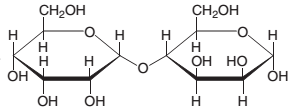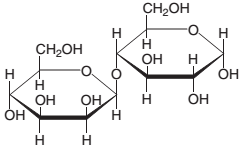
EBK GENERAL, ORGANIC, & BIOLOGICAL CHEM
3rd Edition
ISBN: 9781259298424
Author: SMITH
Publisher: VST
expand_more
expand_more
format_list_bulleted
Concept explainers
Question
Chapter 20, Problem 20.59P
Interpretation Introduction
(a)
Interpretation:
Monosaccharide formed after the hydrolysis of given disaccharides needs to be determined.

Concept introduction:
When disaccharides are hydrolyzed, a water molecule is added between the glycosidic bond that holds the monosaccharide together and results in the formation of respective monosaccharide.
Interpretation Introduction
(b)
Interpretation:
Monosaccharide formed after the hydrolysis of given disaccharides needs to be determined.

Concept introduction:
When disaccharides are hydrolyzed, a water molecule is added between the glycosidic bond that holds the monosaccharide together and results in the formation of respective monosaccharide.
Expert Solution & Answer
Want to see the full answer?
Check out a sample textbook solution
Students have asked these similar questions
Steps and explanation please
can you please draw out and list step-by-step the synthetic strategy for this rxn? thank you sm in advance
Steps and explanations please
Chapter 20 Solutions
EBK GENERAL, ORGANIC, & BIOLOGICAL CHEM
Ch. 20.1 - Label the hemiacetal carbonthe carbon bonded to...Ch. 20.1 - Prob. 20.2PCh. 20.1 - Prob. 20.3PCh. 20.1 - Prob. 20.4PCh. 20.1 - Prob. 20.5PCh. 20.2 - Prob. 20.6PCh. 20.2 - Prob. 20.7PCh. 20.2 - Prob. 20.8PCh. 20.2 - Prob. 20.9PCh. 20.2 - Prob. 20.10P
Ch. 20.3 - Prob. 20.11PCh. 20.3 - Prob. 20.12PCh. 20.4 - Prob. 20.13PCh. 20.4 - Prob. 20.14PCh. 20.4 - Prob. 20.15PCh. 20.4 - Prob. 20.16PCh. 20.4 - Prob. 20.17PCh. 20.4 - Prob. 20.18PCh. 20.5 - Lactose contains both an acetal and a hemiacetal....Ch. 20.5 - Prob. 20.20PCh. 20.5 - Prob. 20.21PCh. 20.6 - Prob. 20.22PCh. 20.6 - Prob. 20.23PCh. 20.7 - Prob. 20.24PCh. 20.7 - Prob. 20.25PCh. 20.8 - Prob. 20.26PCh. 20 - Prob. 20.27PCh. 20 - Prob. 20.28PCh. 20 - Prob. 20.29PCh. 20 - Prob. 20.30PCh. 20 - Prob. 20.31PCh. 20 - Prob. 20.32PCh. 20 - Prob. 20.33PCh. 20 - Prob. 20.34PCh. 20 - Prob. 20.35PCh. 20 - Prob. 20.36PCh. 20 - Prob. 20.37PCh. 20 - Prob. 20.38PCh. 20 - Prob. 20.39PCh. 20 - Prob. 20.40PCh. 20 - Prob. 20.41PCh. 20 - Prob. 20.42PCh. 20 - Prob. 20.43PCh. 20 - Prob. 20.44PCh. 20 - Prob. 20.45PCh. 20 - Prob. 20.46PCh. 20 - Prob. 20.47PCh. 20 - Prob. 20.48PCh. 20 - Prob. 20.49PCh. 20 - Prob. 20.50PCh. 20 - Prob. 20.51PCh. 20 - Prob. 20.52PCh. 20 - Prob. 20.53PCh. 20 - Prob. 20.54PCh. 20 - Prob. 20.55PCh. 20 - Prob. 20.56PCh. 20 - Prob. 20.57PCh. 20 - Prob. 20.58PCh. 20 - Prob. 20.59PCh. 20 - Prob. 20.60PCh. 20 - Prob. 20.61PCh. 20 - Prob. 20.62PCh. 20 - Prob. 20.63PCh. 20 - Prob. 20.64PCh. 20 - Prob. 20.65PCh. 20 - Prob. 20.66PCh. 20 - Prob. 20.67PCh. 20 - Prob. 20.68PCh. 20 - Prob. 20.69PCh. 20 - Prob. 20.70PCh. 20 - Prob. 20.71PCh. 20 - Prob. 20.72PCh. 20 - Prob. 20.73PCh. 20 - Prob. 20.74PCh. 20 - Prob. 20.75PCh. 20 - Prob. 20.76PCh. 20 - Prob. 20.77PCh. 20 - Prob. 20.78PCh. 20 - Prob. 20.79PCh. 20 - Prob. 20.80PCh. 20 - Prob. 20.81PCh. 20 - Prob. 20.82PCh. 20 - Prob. 20.83PCh. 20 - Prob. 20.84PCh. 20 - Prob. 20.85PCh. 20 - Prob. 20.86PCh. 20 - Prob. 20.87CPCh. 20 - Prob. 20.88CP
Knowledge Booster
Learn more about
Need a deep-dive on the concept behind this application? Look no further. Learn more about this topic, chemistry and related others by exploring similar questions and additional content below.Similar questions
- Use diagram to answer the following: 1.Is the overall rxn endo- or exothermic. Explain briefly your answer____________________2. How many steps in this mechanism?_____________3. Which is the rate determining step? Explain briefly your answer____________________4. Identify (circle and label) the reactants,the products and intermediate (Is a Cation, Anion, or a Radical?) Please explain and provide full understanding.arrow_forwardDraw the entire mechanism and add Curved Arrows to show clearly how electrons areredistributed in the process. Please explain and provide steps clearly.arrow_forward15) Create Lewis structure Br Brarrow_forward
- LIOT S How would you make 200. mL of a 0.5 M solution of CuSO4 5H2O from solid copper (II) sulfate? View Rubricarrow_forwardSteps and explantions pleasearrow_forwardMatch the denticity to the ligand. Water monodentate ✓ C₂O2 bidentate H₂NCH₂NHCH2NH2 bidentate x EDTA hexadentate Question 12 Partially correct Mark 2 out of 2 Flag question Provide the required information for the coordination compound shown below: Na NC-Ag-CN] Number of ligands: 20 Coordination number: 2✔ Geometry: linear Oxidation state of transition metal ion: +3 x in 12 correct out of 2 question Provide the required information for the coordination compound shown below. Na NC-Ag-CN] Number of ligands: 20 Coordination number: 2 Geometry: linear 0 Oxidation state of transition metal ion: +3Xarrow_forward
- Can you explain step by step behind what the synthetic strategy would be?arrow_forwardPlease explain step by step in detail the reasoning behind this problem/approach/and answer. thank you!arrow_forward2. Predict the product(s) that forms and explain why it forms. Assume that any necessary catalytic acid is present. .OH HO H₂N OHarrow_forward
- consider the rate of the reaction below to be r. Whats the rate after each reaction? Br + NaCN CN + NaBr a. Double the concentration of alkyl bromide b. Halve the concentration of the electrophile & triple concentration of cyanide c. Halve the concentration of alkyl chloridearrow_forwardPredict the organic reactant that is involved in the reaction below, and draw the skeletal ("line") structures of the missing organic reactant. Please include all steps & drawings & explanations.arrow_forwardWhat are the missing reagents for the spots labeled 1 and 3? Please give a detailed explanation and include the drawings and show how the synthesis proceeds with the reagents.arrow_forward
arrow_back_ios
SEE MORE QUESTIONS
arrow_forward_ios
Recommended textbooks for you
- Chemistry: Matter and ChangeChemistryISBN:9780078746376Author:Dinah Zike, Laurel Dingrando, Nicholas Hainen, Cheryl WistromPublisher:Glencoe/McGraw-Hill School Pub Co
 General, Organic, and Biological ChemistryChemistryISBN:9781285853918Author:H. Stephen StokerPublisher:Cengage Learning
General, Organic, and Biological ChemistryChemistryISBN:9781285853918Author:H. Stephen StokerPublisher:Cengage Learning Organic And Biological ChemistryChemistryISBN:9781305081079Author:STOKER, H. Stephen (howard Stephen)Publisher:Cengage Learning,
Organic And Biological ChemistryChemistryISBN:9781305081079Author:STOKER, H. Stephen (howard Stephen)Publisher:Cengage Learning,  Chemistry for Today: General, Organic, and Bioche...ChemistryISBN:9781305960060Author:Spencer L. Seager, Michael R. Slabaugh, Maren S. HansenPublisher:Cengage Learning
Chemistry for Today: General, Organic, and Bioche...ChemistryISBN:9781305960060Author:Spencer L. Seager, Michael R. Slabaugh, Maren S. HansenPublisher:Cengage Learning Introduction to General, Organic and BiochemistryChemistryISBN:9781285869759Author:Frederick A. Bettelheim, William H. Brown, Mary K. Campbell, Shawn O. Farrell, Omar TorresPublisher:Cengage Learning
Introduction to General, Organic and BiochemistryChemistryISBN:9781285869759Author:Frederick A. Bettelheim, William H. Brown, Mary K. Campbell, Shawn O. Farrell, Omar TorresPublisher:Cengage Learning World of ChemistryChemistryISBN:9780618562763Author:Steven S. ZumdahlPublisher:Houghton Mifflin College Div
World of ChemistryChemistryISBN:9780618562763Author:Steven S. ZumdahlPublisher:Houghton Mifflin College Div

Chemistry: Matter and Change
Chemistry
ISBN:9780078746376
Author:Dinah Zike, Laurel Dingrando, Nicholas Hainen, Cheryl Wistrom
Publisher:Glencoe/McGraw-Hill School Pub Co

General, Organic, and Biological Chemistry
Chemistry
ISBN:9781285853918
Author:H. Stephen Stoker
Publisher:Cengage Learning

Organic And Biological Chemistry
Chemistry
ISBN:9781305081079
Author:STOKER, H. Stephen (howard Stephen)
Publisher:Cengage Learning,

Chemistry for Today: General, Organic, and Bioche...
Chemistry
ISBN:9781305960060
Author:Spencer L. Seager, Michael R. Slabaugh, Maren S. Hansen
Publisher:Cengage Learning

Introduction to General, Organic and Biochemistry
Chemistry
ISBN:9781285869759
Author:Frederick A. Bettelheim, William H. Brown, Mary K. Campbell, Shawn O. Farrell, Omar Torres
Publisher:Cengage Learning

World of Chemistry
Chemistry
ISBN:9780618562763
Author:Steven S. Zumdahl
Publisher:Houghton Mifflin College Div